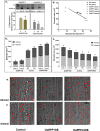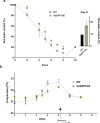Rice plants overexpressing OsEPF1 show reduced stomatal density and increased root cortical aerenchyma formation
- PMID: 30944383
- PMCID: PMC6447545
- DOI: 10.1038/s41598-019-41922-7
Rice plants overexpressing OsEPF1 show reduced stomatal density and increased root cortical aerenchyma formation
Erratum in
-
Author Correction: Rice plants overexpressing OsEPF1 show reduced stomatal density and increased root cortical aerenchyma formation.Sci Rep. 2019 Oct 10;9(1):14827. doi: 10.1038/s41598-019-51402-7. Sci Rep. 2019. PMID: 31597936 Free PMC article.
Abstract
Stomata are adjustable pores in the aerial epidermis of plants. The role of stomata is usually described in terms of the trade-off between CO2 uptake and water loss. Little consideration has been given to their interaction with below-ground development or diffusion of other gases. We overexpressed the rice EPIDERMAL PATTERNING FACTOR1 (OsEPF1) to produce rice plants with reduced stomatal densities, resulting in lowered leaf stomatal conductance and enhanced water use efficiency. Surprisingly, we found that root cortical aerenchyma (RCA) is formed constitutively in OsEPF1OE lines regardless of tissue age and position. Aerenchyma is tissue containing air-spaces that can develop in the plant root during stressful conditions, e.g. oxygen deficiency when it functions to increase O2 diffusion from shoot to root. The relationship with stomata is unknown. We conclude that RCA development and stomatal development are linked by two possible mechanisms: first that reduced stomatal conductance inhibits the diffusion of oxygen to the root, creating an oxygen deficit and stimulating the formation of RCA, second that an unknown EPF signalling pathway may be involved. Our observations have fundamental implications for the understanding of whole plant gas diffusion and root-to-shoot signalling events.
Conflict of interest statement
The authors declare no competing interests.
Figures








References
-
- Jones RJ, Mansfield TA. Suppression of Stomatal Opening in Leaves Treated with Abscisic Acid. Journal of Experimental Botany. 1970;21:714–719. doi: 10.1093/jxb/21.3.714. - DOI
-
- Holbrook NM, Shashidhar V, James RA, Munns R. Stomatal control in tomato with ABA‐deficient roots: response of grafted plants to soil drying. Journal of Experimental Botany. 2002;53:1503–1514. - PubMed
-
- Caine Robert S., Yin Xiaojia, Sloan Jennifer, Harrison Emily L., Mohammed Umar, Fulton Timothy, Biswal Akshaya K., Dionora Jacqueline, Chater Caspar C., Coe Robert A., Bandyopadhyay Anindya, Murchie Erik H., Swarup Ranjan, Quick W. Paul, Gray Julie E. Rice with reduced stomatal density conserves water and has improved drought tolerance under future climate conditions. New Phytologist. 2018;221(1):371–384. doi: 10.1111/nph.15344. - DOI - PMC - PubMed
Publication types
Grants and funding
LinkOut - more resources
Full Text Sources
Other Literature Sources

